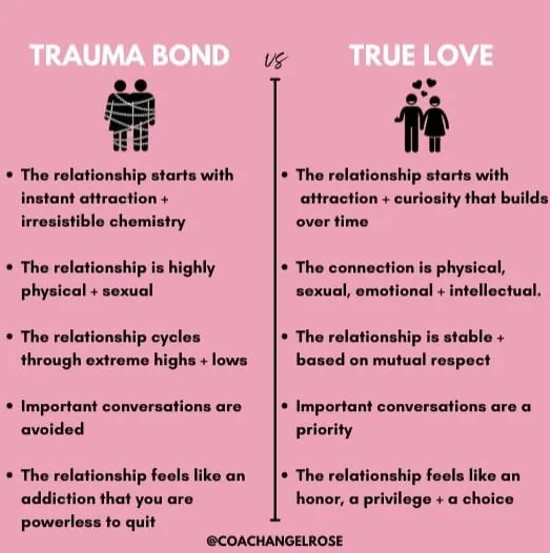BOURSESSENEGAL – A trauma bond forms when two people share a relationship characterized by intense emotional experiences, often involving manipulation or abuse. These bonds can create a powerful, confusing connection that makes it challenging for individuals to break free from unhealthy dynamics. Understanding trauma bonds is crucial for those seeking to regain control over their lives and relationships. In this comprehensive guide, we’ll explore what trauma bonds are, how they form, the signs to look for, and steps to heal from them.
What is a Trauma Bond?
The Nature of Trauma Bonds
A trauma bond occurs when an individual feels a strong emotional attachment to another person despite experiencing distressing or harmful situations. Often found in abusive relationships, these bonds develop through a cycle of abuse followed by reconciliation. This push-and-pull dynamic creates confusion and dependency, making it difficult for individuals to leave.
The Psychological Mechanism
The psychological underpinning of trauma bonds involves the interplay of fear, love, and loyalty. Victims often feel a sense of loyalty to their abuser, believing they can change or that the relationship has redeeming qualities. This cognitive dissonance can make it hard for individuals to recognize the toxicity of their situation.
How Trauma Bonds Form
1. Intense Emotional Experiences
Trauma bonds usually start with a whirlwind of intense emotions. Victims often experience high highs followed by deep lows. This emotional rollercoaster creates a heightened state of attachment, making it difficult to see the situation objectively.
2. Cycle of Abuse and Reconciliation
Many trauma bonds develop within the cycle of abuse. After an abusive incident, the abuser may apologize, express remorse, or shower their partner with affection. This temporary reprieve reinforces the bond, leading the victim to believe the relationship can improve.
3. Isolation from Support Systems
Abusers often isolate their partners from friends and family. This isolation makes it harder for victims to seek help, further deepening the trauma bond. Without a support network, victims may rely solely on their abuser for emotional fulfillment.
Signs of a Trauma Bond
1. Difficulty Leaving the Relationship
One of the most telling signs of a trauma bond is the inability to leave an unhealthy relationship. Even when you recognize the toxicity, the emotional attachment can keep you stuck.
2. Justifying Harmful Behavior
Victims may find themselves rationalizing the abuser’s actions. Thoughts like, “They didn’t mean to hurt me” or “I can help them change” are common.
3. Experiencing Fear and Guilt
Many individuals in trauma bonds experience a mix of fear and guilt. They fear losing their partner and feel guilty for wanting to leave. This emotional turmoil complicates their decision-making.
4. Heightened Anxiety and Stress
Living in a state of uncertainty can lead to increased anxiety and stress. Victims may constantly worry about their partner’s mood or behavior, leading to emotional exhaustion.
5. Emotional Rollercoaster
The intense emotional highs and lows associated with trauma bonds can be exhausting. Victims may feel euphoric during moments of affection but plummet into despair during episodes of abuse.
Breaking Free from a Trauma Bond
1. Acknowledge the Bond
The first step in breaking free from a trauma bond is acknowledging its existence. Understanding that you are in a toxic relationship is crucial for initiating change.
2. Seek Professional Help
Therapy can be invaluable for individuals grappling with trauma bonds. A mental health professional can provide guidance, support, and coping strategies tailored to your situation.
3. Build a Support Network
Reconnecting with friends and family can help break the isolation that trauma bonds create. Surround yourself with supportive people who can offer encouragement and perspective.
4. Establish Boundaries
Setting boundaries with your partner is essential for regaining control. Clearly communicate what behaviors are unacceptable and be firm in enforcing those limits.
5. Focus on Self-Care
Engage in self-care activities that promote emotional and physical well-being. Exercise, mindfulness, and hobbies can help rebuild your sense of self outside the relationship.
6. Create an Exit Plan
If leaving the relationship feels necessary, develop a practical exit plan. Consider your safety and make arrangements for financial independence and housing if needed.
7. Educate Yourself
Understanding trauma bonds and the dynamics of abuse can empower you. Knowledge is a powerful tool in recognizing unhealthy patterns and protecting yourself.
Healing from Trauma Bonds
1. Allow Time to Grieve
Healing from a trauma bond involves grieving the relationship and the future you envisioned. Give yourself permission to feel sadness, anger, or loss. These emotions are a natural part of the healing process.
2. Reflect on the Experience
Taking time to reflect on the relationship can provide insights into your patterns and vulnerabilities. Journaling or discussing your experiences with a therapist can help clarify your thoughts.
3. Rebuild Trust in Yourself
Trauma bonds can erode your self-esteem and trust in your judgment. Focus on rebuilding this trust by making decisions that align with your values and needs.
4. Foster Healthy Relationships
As you heal, seek out relationships that are supportive and healthy. Surrounding yourself with positive influences can help reinforce your progress.
5. Practice Mindfulness
Mindfulness techniques, such as meditation and deep breathing, can help reduce anxiety and promote emotional healing. These practices can ground you in the present moment and reduce overthinking.
6. Celebrate Small Victories
Recognize and celebrate your progress, no matter how small. Each step you take toward healing and independence is significant and deserves acknowledgment.
Conclusion
Understanding a trauma bond is the first step toward breaking free from its grip. By recognizing the signs, seeking support, and prioritizing self-care, you can reclaim your life and create healthier relationships. Remember, healing takes time, and it’s okay to seek help along the way. You have the power to break the cycle and emerge stronger than ever. Embrace the journey of healing, and remember that you deserve a life filled with love, respect, and freedom.
REFERENCE : odin99



